
|   |

|   |
Darpanam - Padma Jayaraj e-mail: padmajayaraj@gmail.com October 10, 2015 ‘Darpanam’ in Malayalam means mirror. The painting exhibition showcased in the art gallery of Lalitkala Akademi, Thrissur, Kerala (September 9 to 14) was indeed a mirror: a mirror that reflected the attempts of a bunch of young artists who try to create space for themselves in the changing art scene. It is a mirror that reflects the trajectory that art takes as it evolves from tradition through innovations. The first public display of the works of these upcoming artists announces their presence with their 35 paintings, which deserves encouragement. The paintings, acrylic on canvas, fall mainly into two categories: traditional and creational. Murals of Kerala are traditional wall paintings associated with temple arts. Most of these artists are trained in the Mural Institute in Guruvayoor, Kerala, that was founded for the revival of a lost art. Sprung from temple walls, traditional murals depict divine beings in iconic dimensions. With the passage of time, liberated from temple precincts, murals today indicate a style of painting. 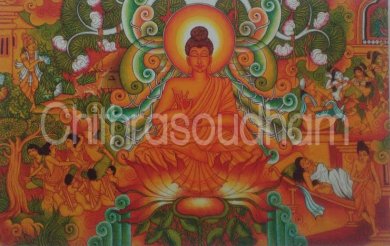
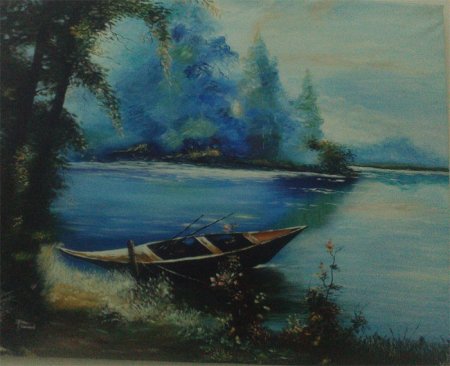
The artist explained the process of traditional mural painting. Of course today the temple walls are replaced by canvas. Washed in luminous white, the canvas receives the copy of the sketch in basic 3 colours (red, green and yellow). The finishing is done with the magic touch of the black line at one go, highlighting the contours of the figure and giving the designer’s touch to the white. The Salabanjikas of Jithin Panthra suggest its temple associations besides the narrative of its story in the evolution of art. In Buddhist lore, the salabanjika is a divine spirit holding a leafy branch of the Sala tree, probably symbolizing Nature. Later in Hindu temples, she is just a being endowed with divinity playing many roles. The exhibition starts with a salabanjika. And she is present here and there in slightly different forms to create a hallowed feel. Prabheesh, Cheramanur, gives the picture of the sage Vedavyasa who edited the Vedas and his role in shaping a philosophy of Vedic times. The Buddha in meditation is another traditional style painting. The innovation is seen in the background. The still backdrop of plants and the lotus above the surface of water reflects the inner state of the mind in higher stages of meditation. It also tells the life journey of Prince Siddhartha from palace to the Buddha who initiated a different philosophy that shaped the subcontinent. Arunodayam by Mukesh Kumar is special because the painting projects Aruna, the charioteer of Soorya, even when Soorya looms large in the backdrop. Aruna is twilight personified. The dancing Ganapathy is notable for its color scheme which deviates from the traditional mural. 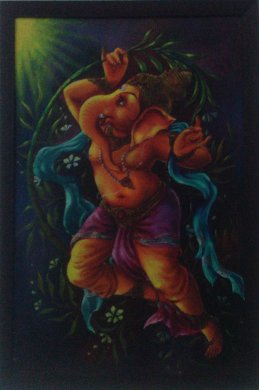
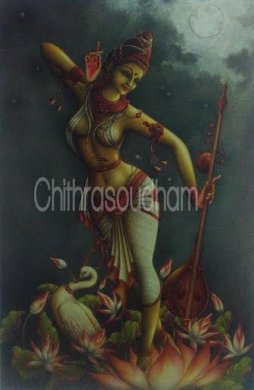
The creational paintings of Krishnakumar liberate traditional figures from temple associations. His Sarswathy is more like a character than a deity. Ardhanariswara and Radha-Krishna by Sreerag, Kozhikode, are thematically interesting as harmonies of the male-female principles in highly evolved beings. The semi-abstract landscapes are artistic delights inducing a love for nature. The mountain pass in deep shadows (Rajendran N.K) echo a million footfalls down the millennia. It tells the story of migration of civilizations through human history. The tree-lined, sun-kissed avenue that disappears in the distance is a beautiful painting of a modern landscape (Pramode). The piece reminds you of the ‘Green tunnel’ in Kashmir. The fact that it disappears into the future is a continuation of the theme of journeys that peoples take. 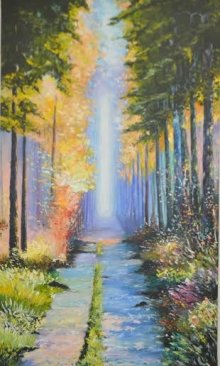 The art photography inspired paintings are unique with the artist’s singular stamp. The swimmer emerging from the waterfall, the dancer merged in the whirling dance created by Akash Menon, are something that you carry in your memory. The cast of the bust of a female nude is by a self-taught artist, Sukumaran, who is the founder of Chitra Saudham, Vasan Memorial Art Gallery in Thrissur to promote art. Padma Jayaraj is a freelance writer on the arts. She is a regular contributor to narthaki.com. |